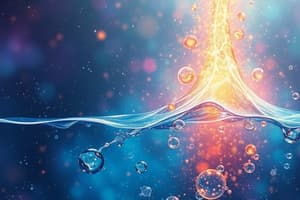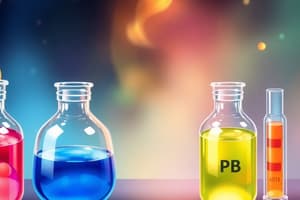Podcast
Questions and Answers
What type of acid is capable of donating two protons (H+)?
What type of acid is capable of donating two protons (H+)?
- Monoprotic acid
- Diprotic acid (correct)
- Weak acid
- Triprotic acid
Which term describes a solution that resists changes in pH when small amounts of acid or base are added?
Which term describes a solution that resists changes in pH when small amounts of acid or base are added?
- Indicator
- Buffer solution (correct)
- Strong acid
- Conjugate pair
What occurs during a Bronsted Lowry acid-base reaction?
What occurs during a Bronsted Lowry acid-base reaction?
- Formation of hydronium ions
- Complete dissociation in water
- Physical change of state
- A proton (H+) donor (correct)
What is the term for a substance that can act as both an acid and a base?
What is the term for a substance that can act as both an acid and a base?
What is the value of the ion product of water (Kw) at room temperature?
What is the value of the ion product of water (Kw) at room temperature?
What describes the relationship between a conjugate acid and its corresponding base?
What describes the relationship between a conjugate acid and its corresponding base?
Which statement correctly defines a diprotic acid?
Which statement correctly defines a diprotic acid?
In a buffer solution, which component plays a crucial role in maintaining pH stability?
In a buffer solution, which component plays a crucial role in maintaining pH stability?
What is true about strong acids in aqueous solution?
What is true about strong acids in aqueous solution?
What is the primary role of an indicator in acid-base chemistry?
What is the primary role of an indicator in acid-base chemistry?
What defines a monoprotic acid?
What defines a monoprotic acid?
What happens to a buffer solution when excess strong acid is added?
What happens to a buffer solution when excess strong acid is added?
Which statement correctly describes amphoteric substances?
Which statement correctly describes amphoteric substances?
What is the role of a conjugate acid in an acid-base reaction?
What is the role of a conjugate acid in an acid-base reaction?
What is the significance of the buffer capacity in a buffer solution?
What is the significance of the buffer capacity in a buffer solution?
What is the primary function of a conjugate base in an acid-base reaction?
What is the primary function of a conjugate base in an acid-base reaction?
Which of the following correctly describes buffer capacity?
Which of the following correctly describes buffer capacity?
What characterizes a weak acid when it is placed in water?
What characterizes a weak acid when it is placed in water?
What happens to the pH of a buffer solution when a small amount of a strong base is added?
What happens to the pH of a buffer solution when a small amount of a strong base is added?
Which statement is true about triprotic acids?
Which statement is true about triprotic acids?
What is produced when an acid is placed in water?
What is produced when an acid is placed in water?
In an acid-base reaction, what type of species is a Bronstead Lowry base?
In an acid-base reaction, what type of species is a Bronstead Lowry base?
What distinguishes a strong acid from a weak acid in aqueous solution?
What distinguishes a strong acid from a weak acid in aqueous solution?
Which of the following correctly defines a buffer solution?
Which of the following correctly defines a buffer solution?
What happens to the pH of a solution if a strong acid is added to a buffer solution?
What happens to the pH of a solution if a strong acid is added to a buffer solution?
Flashcards are hidden until you start studying
Study Notes
Acids and Bases
- Acid: A substance that produces hydronium ions (H3O+) when placed in water.
- Base: A substance that produces hydroxide ions (OH-) when placed in water.
- Brønsted-Lowry Acid: A proton (H+) donor.
- Brønsted-Lowry Base: A proton (H+) acceptor.
- Amphoteric (Amphiprotic): A substance that can act as both an acid and a base.
Conjugate Pairs
- Conjugate Acid: Formed by adding a proton (H+) to a base.
- Conjugate Base: Formed by removing a proton (H+) from an acid.
- Conjugate Acid-Base Pair: Any pair of molecules or ions that can be interconverted by transferring a proton.
Acid Strength
- Strong Acid: Dissociates completely (100%) in water.
- Weak Acid: Dissociates partially (less than 100%) in water.
- Monoprotic Acid: Can donate only one proton (H+).
- Diprotic Acid: Can donate two protons (H+).
- Triprotic Acid: Can donate three protons (H+).
pH and pOH
- pH: A measure of the acidity or alkalinity of a solution, defined as the negative logarithm of the hydronium ion concentration (-log[H3O+]).
- Ion Product of Water (Kw): In pure water at room temperature, Kw has a value of 1.0 x 10^-14.
Buffers
- Buffer Solution: A solution that resists changes in pH when limited amounts of acid or base are added.
- Buffer Capacity: The maximum amount of acid or base that can be added before the buffer stops working.
- Common Buffer: An aqueous solution containing a weak acid and its conjugate base.
Indicators
- Indicator: A substance that changes color at a specific pH, used to determine the pH of a solution.
Acids and Bases
- Acid: Produces hydronium ions (H3O+) when placed in water.
- Base: Produces hydroxide ions (OH-) when placed in water.
- Brønsted-Lowry Acid: Donates a proton (H+).
- Brønsted-Lowry Base: Accepts a proton (H+).
- Amphoteric (Amphiprotic): Can act as both an acid and a base.
- Conjugate Acid: Formed when a base accepts a proton (H+).
- Conjugate Base: Formed when an acid loses a proton (H+).
- Conjugate Acid-Base Pair: Two molecules or ions that differ by a single proton (H+).
Acid-Base Reactions
- Acid-Base Reaction: A proton (H+) transfer reaction.
- Hydronium Ion: H3O+
- Ion Product of Water (Kw): At room temperature, Kw = 1.0 x 10^-14.
Strength of Acids and Bases
- Strong Acid/Strong Base: Dissociates completely (100%) in water.
- Weak Acid/Weak Base: Dissociates partially (less than 100%) in water.
Buffer Solutions
- Buffer Solution: Resists changes in pH when small amounts of acid or base are added.
- Buffer Capacity: Maximum amount of acid or base a buffer can neutralize before its effectiveness is lost.
Polyprotic Acids
- Monoprotic Acid: Can donate only one proton (H+).
- Diprotic Acid: Can donate two protons (H+).
- Triprotic Acid: Can donate three protons (H+).
pH and Indicators
- pH: A measure of the acidity or basicity of a solution; pH = -log[H3O+].
- Indicator: A substance that changes color at a specific pH.
Acids and Bases
- Acids produce hydronium ions (H3O+) when placed in water.
- Bases produce hydroxide ions (OH-) when placed in water.
- An acid-base reaction is a proton (H+) transfer reaction.
- Amphoteric substances can behave as both an acid and a base.
Brønsted-Lowry Theory
- A Brønsted-Lowry acid is a proton (H+) donor.
- A Brønsted-Lowry base is a proton (H+) acceptor.
- A conjugate acid-base pair consists of two species that differ by a single proton (H+).
- The conjugate acid is formed by adding a proton to a base.
- The conjugate base is formed by removing a proton from an acid.
Buffer Solutions
- A buffer solution resists changes in pH when small amounts of acid or base are added.
- A common buffer solution is an aqueous solution containing a weak acid and its conjugate base.
- Buffer capacity is the maximum amount of acid or base a buffer can handle before it stops working.
Strong and Weak Acids/Bases
- Strong acids and bases dissociate completely (100%) in water.
- Weak acids and bases dissociate partially (less than 100%) in water.
Polyprotic Acids
- Monoprotic acids donate only one proton (H+).
- Diprotic acids donate two protons (H+).
- Triprotic acids donate three protons (H+).
pH
- pH measures the acidity or basicity of a solution.
- pH is defined as the negative logarithm of the hydronium ion concentration: pH = -log[H3O+].
- The ion product of water (Kw) is the product of the concentrations of hydronium and hydroxide ions in pure water. At room temperature, Kw = 1.0 x 10-14.
Indicators
- An indicator is a substance that changes color at a specific pH.
Acids and Bases
- Acid: produces hydronium ions (H3O+) when placed in water (e.g., HCl, H2SO4)
- Base: produces hydroxide ions (OH-) when placed in water (e.g., NaOH, KOH)
- Brønsted-Lowry Acid: donates a proton (H+)
- Brønsted-Lowry Base: accepts a proton (H+)
- Amphoteric (Amphiprotic): can act as both an acid and a base (e.g., water, H2O)
Conjugate Acids and Bases
- Conjugate Acid: formed by adding a proton (H+) to a base
- Conjugate Base: formed by removing a proton (H+) from an acid
- Conjugate Acid-Base Pair: two molecules or ions that differ by a single proton (H+)
Strength of Acids and Bases
- Strong Acid/Strong Base: completely dissociates in water (100%)
- Weak Acid/Weak Base: partially dissociates in water (less than 100%)
pH
- pH: a measure of the acidity or alkalinity of a solution; calculated as the negative logarithm of the hydronium ion concentration (pH = -log[H3O+])
- Ion Product of Water (Kw): Kw = [H3O+][OH-] = 1.0 x 10^-14 at 25°C (room temperature)
Buffer Solutions
- Buffer Solution: resists changes in pH when small amounts of acid or base are added
- Key Components: a weak acid and its conjugate base (e.g., acetic acid/acetate)
- Buffer Capacity: the maximum amount of acid or base a buffer can handle before its effectiveness diminishes
Polyprotic Acids
- Monoprotic Acids: donate one proton (H+) (e.g., HCl)
- Diprotic Acids: donate two protons (H+) (e.g., H2SO4)
- Triprotic Acids: donate three protons (H+) (e.g., H3PO4)
Indicators
- Indicator: a substance that changes color at a specific pH range, used to visually determine the approximate pH of a solution
Acids, Bases, and pH
- Acids produce hydronium ions (H3O+) when placed in water.
- Bases produce hydroxide ions (OH-) when placed in water.
- pH measures the acidity or basicity of a solution. It is defined as the negative logarithm of the hydronium ion concentration: pH = -log[H3O+].
Brønsted-Lowry Acid-Base Theory
- Brønsted-Lowry acids are proton donors.
- Brønsted-Lowry bases are proton acceptors.
- A conjugate acid-base pair consists of two species that differ by the presence or absence of a proton (H+). For example, HCl (acid) and Cl- (conjugate base).
Strong and Weak Acids and Bases
- Strong acids and bases dissociate completely in water, meaning they ionize 100%, while weak acids and bases dissociate partially, meaning they ionize less than 100%.
Polyprotic Acids
- Monoprotic acids can donate one proton (H+), like HCl.
- Diprotic acids can donate two protons (H+), like H2SO4.
- Triprotic acids can donate three protons (H+), like H3PO4.
Amphoteric Substances
- Amphoteric substances can act as both acids and bases. Water is a common example.
Buffer Solutions
- Buffer solutions resist changes in pH upon addition of small amounts of acid or base.
- They consist of a weak acid and its conjugate base.
- Buffer capacity refers to the amount of acid or base a buffer can neutralize before its pH changes significantly.
Key Facts
- Ion product of water (Kw): In pure water at room temperature, Kw = 1.0 x 10^-14. This means that [H3O+][OH-] = 1.0 x 10^-14 at 25°C.
- Indicators are substances that change color at a specific pH, making them useful for monitoring pH changes.
Studying That Suits You
Use AI to generate personalized quizzes and flashcards to suit your learning preferences.




